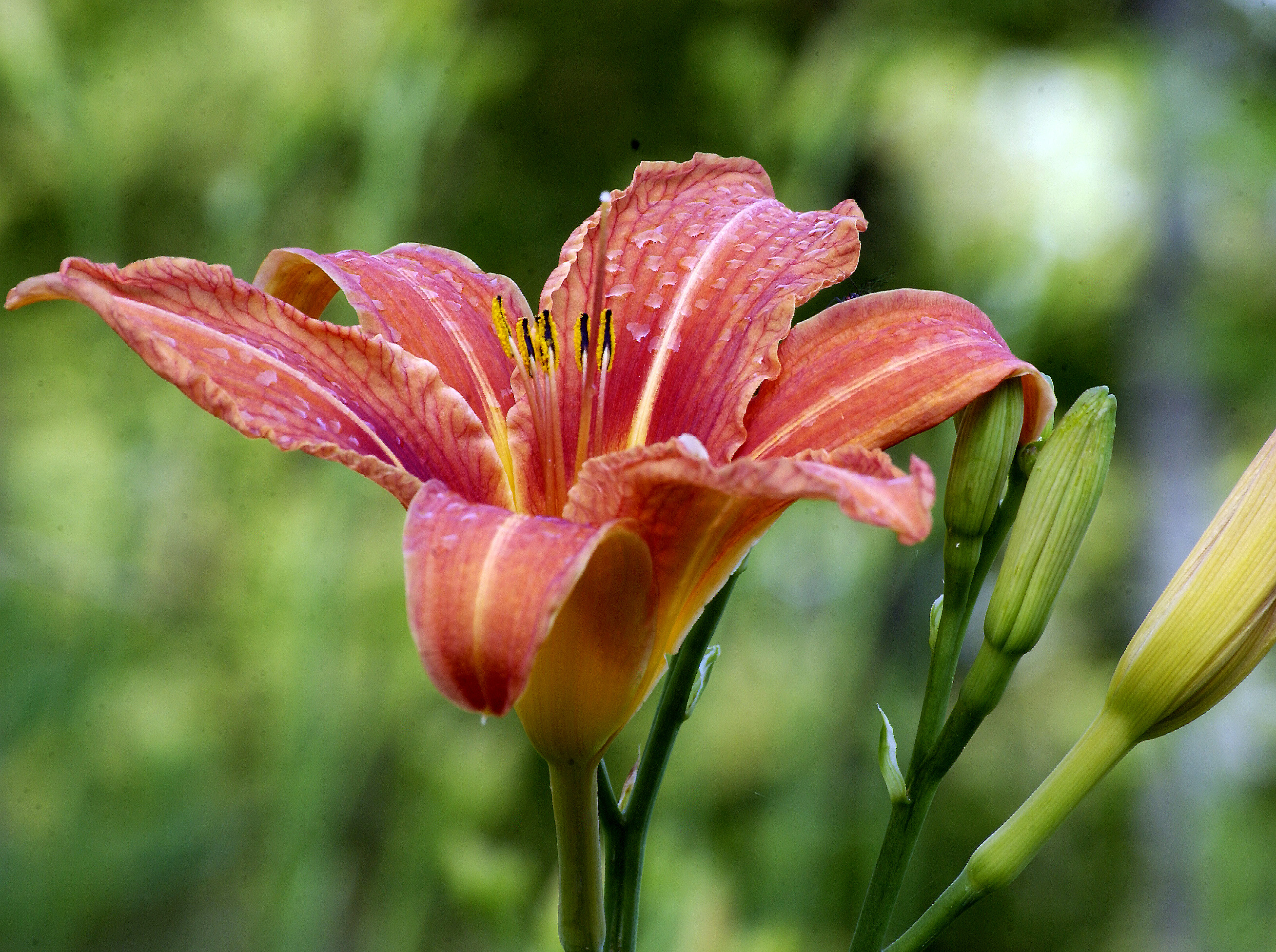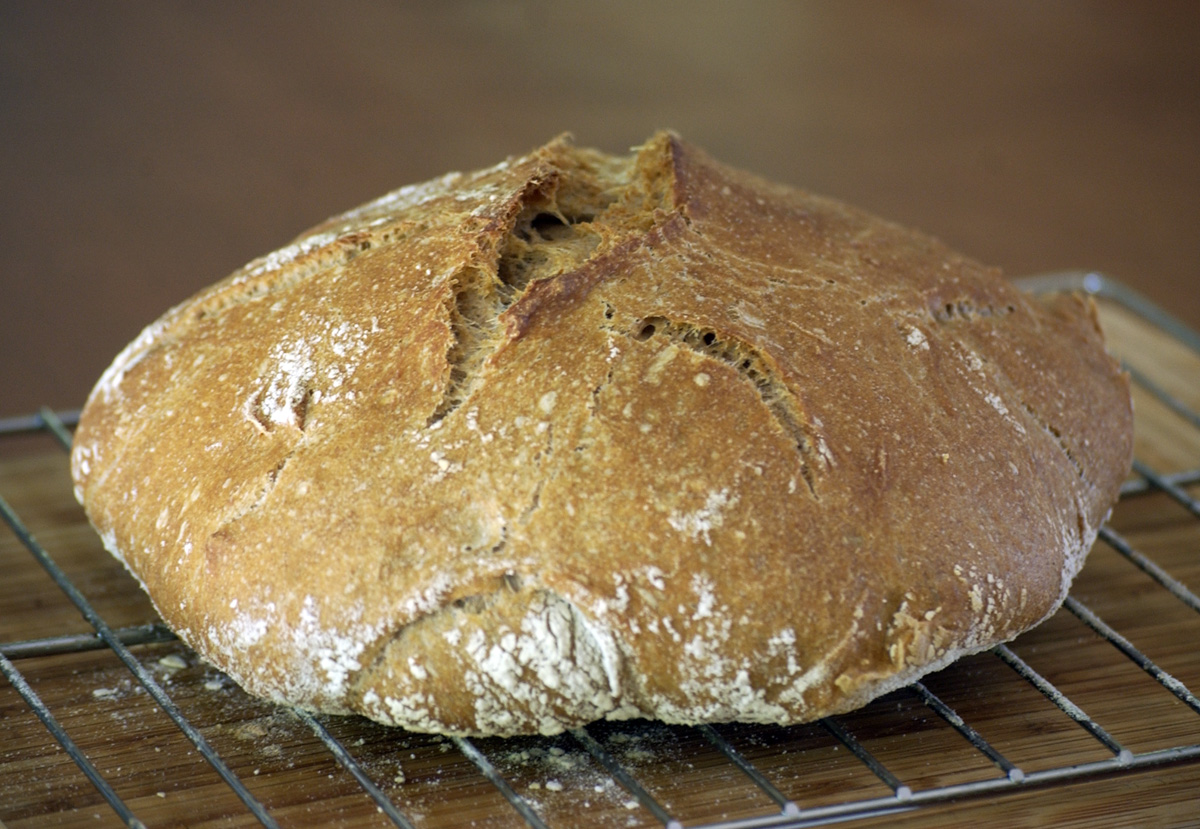
Click on image for high-resolution version
I had thought that the cool spring had delayed the day lilies significantly this year, but when I checked I found that the first day lily was only 4 days later than in 2011.
Watching a bewildering world from the middle of nowhere
Today while mowing the grass, I found the home of a new neighbor. The burrow is only about 20 feet from the side door of the abbey, in a steep bank above a newly planted deciduous magnolia tree. It looks just like a rabbit hole. But my understanding is that the eastern cottontail rabbit, which is the common rabbit here, does not burrow. Rather, they commonly live in brush piles or other homes that they find rather than build themselves.
I’ve seen many groundhog holes, but this hole is too small for groundhogs. So now I am puzzled. I don’t know if there are burrowing rabbits in these parts. There are rabbits here, that’s for sure, because I see them in the yard every day. But I’ve always assumed that they’re cottontail rabbits that live in the brush pile down in the thicket.
Whoever made the hole is very tidy. The landing is very neat, and they’ve spread dry glass on the floor into the burrow.

First test: not too shabby, especially for 75% whole wheat
A week ago, I would have said that no hope existed that I would ever be able to make bread that could begin to compare with the bread one can buy from the excellent bakers of sourdough bread in the San Francisco Bay Area. Now I think it is possible. Michael Pollan’s new book, Cooked, has shown the way.
Part of my problem is that recipes are useless. No recipe can tell you, or teach how, how to make proper bread. Measuring (for example) has nothing to do with it. Rather, the ability to bake good bread can arise only from a deep understanding of how the process works. Pollan’s book has helped me figure out what knowledge I was missing that was holding me back. Don’t get me wrong — I can make delicious breads. But I had no idea how to get to the next level.
Pollan’s main source on bread for this book was Chad Robertson, who runs a bakery in San Francisco and who has a book out named Tartine Bread. When Pollan revealed that Robertson’s instructions for sourdough bread are more than 40 pages long but never quite gives a recipe, I knew that I had finally found my way to the next level. Those 40 pages are about the concepts behind the bread — exactly what I needed.
Here is a summary of some of the new knowledge I’ve gained that has helped fill some of my blind spots and misconceptions:
1. Sourdough is superior to yeast for many reasons. Sourdough bread is actually fermented, and some components of the flour are partially digested, releasing more nutrients and lowering the glycemic index of the bread. The lactic acid generated during the fermentation helps to strengthen the gluten. And gluten, of course, is what makes bread rise. I’ve started a new sourdough culture, which should be ready to use in about a week. My previous sourdough culture died out more than a year ago from neglect.
2. The reasons that whole wheat makes heavier bread can be explained, and there are ways of dealing with it. For one, the bran is sharp, and it cuts and weakens the strands of gluten. Overnight soaking of the flour softens the bran and helps reduce this sharpness. The shaping of the loaf is critical. Steam during the first part of baking is critical.
3. Random kneading of dough is useless. I have come to understand that the point is not just to form the gluten into strands, but to align those strands in such a way that they define the way you want the loaf to go when it rises. That is, the gluten strands form a kind of skeleton for the loaf. The point is to manipulate the dough in such a way that the gluten strands are formed into a skeleton.
4. The main reason steam is critical is that the formation of the crust must be postponed. If the crust forms too soon, it prevents the bread from rising. Throwing water into the oven is one way of dealing with this. But a better way is to bake in a covered Dutch oven. You remove the lid when the bread is about half done, after the loaf has already finished its “oven spring” — the inflation of the loaf when the heat hits it.
5. Maximizing oven spring is critical. The Dutch oven method works nicely. But another factor that is important to good oven spring is building up a proper gluten skeleton by manipulating the dough and to start baking at the right time. Bake too soon and there isn’t enough air in the loaf. Wait too long and the gluten becomes tired. Good oven spring is probably the single most important indicator of good bread and a good baker.
6. The dough must be wet. This probably has been my biggest failing as a baker over the years. Wet dough is difficult to work with. But it must be done.
It will be at least a week before I can attempt my first sourdough loaf. But I did make a loaf of bread with yeast this morning to practice manipulating the dough into a proper boule and to test the Dutch oven method. The loaf was 75 percent whole wheat and 25 percent unbleached white flour. It worked beautifully, and I got excellent “oven spring.” The top of the loaf broke open even though I forgot to slash it with a razor blade before baking.
Michael Pollan’s Cooked is not just about baking. He divides all cookery into four categories — fire (roasting, of meat in particular), water (cooking in pots), air (bread), and earth (fermentation). For each category, he seeks out experts and gets them to reveal their secrets. Though I have some experience with making sauerkraut, Cooked has motivated me to expand my food fermentation skills. And though the abbey’s kitchen is far from a slouchy kitchen, it’s exciting to have new, and higher, goals to aim for.
Low carb quick breads are as easy to make as low carb yeast breads. This morning I made low carb banana bread and used it to make French toast. Instead of regular wheat flour, I used a mixture of 2 parts gluten flour, 2 parts barley flour, 2 parts almond meal, and 1 part soybean flour. Other than that, I followed my usual procedure for making banana bread.
French toast loves to be served with whipped cream. I put a pinch of nutmeg into the cream before whipping it.
This makes a very high protein bread, combining seed (wheat gluten and barley), legume (soy), nuts (almond), and egg.
The barley experiments continue. I am coming to the conclusion that anything rice will do, pearled barley will do better. I have made barley stir fries, barley pilaf, and barley risotto. With barley, you get much lower carbs, more flavor, and a meatier, more satisfying chew.
I’ve also bought some hulled barley, which like pearled barley is available in bulk at Whole Foods. Hulled barley, however, needs to be soaked overnight before it’s cooked. And it takes longer to cook — about an hour for hulled barley vs. 25 minutes or so for pearled barley. So with hulled barley you need to plan ahead a bit.
The barley experiments continue. I’m also experimenting with another low-carb ingredient — almond meal. These cinnamon rolls were made this morning with about 1/3 gluten flour, 1/3 barley flour, and 1/3 almond meal. That’s a good, high-protein low-carb combination. Of course there’s a bit of powdered sugar (and butter and cinnamon), but I kept the sugar content as low as possible.
As I’ve mentioned before here, I have no problems with gluten, and I see no reason to avoid it in my own cooking. Though there can be little doubt that gluten intolerance is increasing in the population, I have doubts that the wheat — or gluten — is really to blame. Some people are skeptical that it’s true that no genetically modified wheat is grown in this country, but if you do some research, I think you’ll find that that’s the case. There is increasing evidence that the real problem is with people’s intestinal flora, not with gluten. Again, you’d have to do your own research. But I’d encourage people to be highly skeptical of the industry that has grown up around the demonization of wheat.
A little bit of gluten flour goes a long way. Actually, 1/3 gluten flour was a bit too much, so I’ll reduce it next time. There can be no bread without gluten. I believe I could make bread out of granite sand if I used about 1/3 gluten flour. By adding gluten, it’s easy to get beautiful bread out of heavy ingredients such as barley flour and almond meal.
Barley is great in soups, but the real test of a grain is: Can you make bread out of it?
Lately I’ve been experimenting with barley, as new research has come out about what a healthy food it is. For one, barley is low on the glycemic index, meaning that it doesn’t spike your blood sugar the way wheat bread does. Barley also promotes a beneficial form of fermentation in the digestive system, so, like yogurt, it’s good for our intestinal flora. And it’s low-carb. Research has shown that when you eat barley, you eat less at the next two meals. That’s the opposite of what high-carb foods do. High-carb foods make us hungrier at the next meal.
Barley contains little or no gluten. That means that you can’t make bread out of 100 percent barley. It won’t rise. It’s the gluten that gives bread its structure. Usually this problem is solved by mixing about 1 part barley flour with 3 or 4 parts wheat flour. But then you have a carby bread that’s only marginally healthier than wheat bread.
Googling around, I found many versions of barley bread. But no one seemed to think of the obvious solution for barley bread: Just add enough wheat gluten flour to give structure to the bread.
That’s what I did yesterday, and the result was delicious. I used about 1 part gluten flour to 4 parts barley flour. It rose beautifully.
Both barley flour and gluten flour can be bought at places like Whole Foods.
Barley bread has a delicious taste. It’s not all that different from wheat bread, but it’s an old-fashioned, rustic taste that I would describe as hobbity.